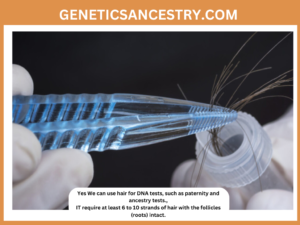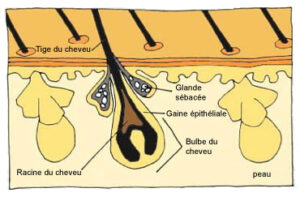Introduction
Hair DNA test, after hearing the term some crime scenes may come to your mind. But nowadays a hair DNA test is done not only to find a criminal but also to find your genetic connections. But do you know it is sometimes considered as an unreliable source as forensic evidence.
According to FBI reports, microscopic analysis of hair was incorrect most of the time. So using hair DNA testing for determining ancestry can be a skeptical process. Can You Do a DNA Test with Hair? To get your answers to more questions, keep reading the article till the end.
DNA Test with Hair, is it possible?
Hair has been used as a source of DNA testing for many decades. To know this better we need to know about the chemical formation of hair. Hair is made up of keratin, a protein and the root of each hair strand contains a follicle. This follicle contains the DNA.
During plucking of the hair strand, the DNA containing the follicle is also removed from the hair strand. Thus, accessing hair follicle DNA is one of the critical aspects of hair DNA testing. This makes paternity test hair without roots a little difficult.
Know the varieties of DNA test
Can a DNA test be done using hair? Yes, but other alternatives are available. You can carry out DNA tests at home with hair follicles for a variety of tests. They are,
- Paternity Testing
- Drug Testing
- Forensic Identification
- Medical Testing
- Paternity Testing, and more
Process to do a DNA test at home with hair for paternity
Here are some simple steps that describe the whole process of DNA test at home with hair.
- Usually the collected DNA sample is taken for further processing and the DNA within the hair sample is amplified or copied many times. Thus there is enough of it to be analyzed.
- Then the dinner taken from the hair sample will be amplified a number of times so that it becomes easy to analyze for the process of amplification of DNA known as polymerase chain reaction.
- Next the DNA is projected to heat as a result it separates into two single strands. Taq polymerase, an enzyme, is used on samples to produce and uses the original DNA strands to generate two new strands of DNA. This process is repeated several times by technicians.
- Then the laboratory technician compares the newly formed DNA strand with the father’s DNA strand from the hair and determines the similarities.
Hope you got a clear idea about how to do a DNA test at home with hair for paternity.
Hair is needed for a DNA test, but how many?
An important section for one who wants to do a DNA test at home with hair. One needs to have a sample of multiple hair strands, say 7 to 10 along with the impact follicles to get the best and desired results from a hair DNA test. This is how much hair is needed for a DNA test.
So the question may arise in your mind, can you get DNA from hair without the root? No, because the root of a hair strand contains DNA. It is important to look at the end of the hair root closely to ensure that the hair sample has necessary follicles attached to it. You can identify the hair follicle easily, as an intact follicle will seem to appear a little thicker at the roots and a tiny light color bulb is visible there. This bulb is called dermal papilla. After your sample is ready you can process it further for the beginning extraction process.
Paternity Testing With Hairs
The Advantages of a Hair DNA test
Hair is used as a sample for DNA tests for several years. Here some advantages are discussed below that a DNA test at home with hair provides.
- Hair DNA test near me is an invasive process and can be a great option for those who are uncomfortable with cheek swabs. This gives a more comfortable and convenient experience.
- Hair DNA testing method is quite a reliable method for identification. It is often used in forensic and criminal investigations.
- Hair DNA testing is cheaper than other types of testing such as blood testing.
- Discrete sample collection from hair can be done.
Drawbacks of Hair DNA Test
What part of hair has DNA? Read to know more. While hair is usually thought to be a viable and accurate material for DNA testing, there are certain drawbacks, such as:
- The follicle must be present in hair samples. Hair clippings and shedding hair collected on a brush are not suitable specimens. The hair follicle must be present in a hair sample used for DNA testing. Accredited industry professionals will strongly advise against using a hair sample that does not contain a follicle for DNA testing, despite claims to the contrary from some DNA testing companies.
- Optimal Procedure Needs More Than One Hair. The hair sample must not only have the follicle connected, but it should also contain multiple hairs; the industry guideline for an acceptable sample size is seven to ten hairs.
Read More At:
- Who Are Black Dutch? Where Are they Located? Ethnicity And DNA
- What is Scandinavian DNA Ethnicity? | Viking Ancestry
- What is a DNA Triangulation? Unraveling the Genetic Puzzle
- How to Find Your Biological Father Without DNA Test
- Nebula Genomics DNA Testing Reviews And Accuracy
Do our hair strands age?
Similar to our skin, our hair’s DNA also gets prone to damage with time. Most of the time we look for changes in our face, neck and hands for aging but we forget to look at our scalps. Also just like the other parts of our body our hair gets damaged with time. There are many factors that can affect our hair’s overall health like different styling processes, washing care and so on. Environmental factors and stress can also affect the nutrients and blood flow in our scalp and hair.
Accuracy of Hair DNA Test
People usually wonder about the hair DNA test accuracy with hair at home. The accuracy of a hair DNA test at home depends on several factors. It includes a testing provider. But if necessary precautions are not taken while carrying out DNA tests at home with hair, then it is more likely to produce inaccurate results. It is seen that the success rate of DNA tests in home using here is around up to 80%. But one should keep in mind that these results depend upon the handling and safekeeping of the samples during the evaluation process.
| Aspect | Description |
| Components of Test Kit | Hair collection tools (e.g., swabs, brushes) |
| Sample collection containers | |
| Preservatives or storage solutions | |
| Instruction manual | |
| Return envelope (for sending samples to the testing facility) | |
| Sample Collection Process | Brushing or swabbing technique |
| Placement of samples in containers | |
| Application of preservatives (if required) | |
| Packaging for shipment | |
| DNA Extraction and Analysis | Laboratory equipment (centrifuges, PCR machines, etc.) |
| Chemicals and reagents used in DNA extraction | |
| Amplification of DNA segments through PCR (Polymerase Chain Reaction) | |
| Gel electrophoresis or sequencing for analysis | |
| Data Interpretation and Reporting | Representation of DNA profiles |
| Matching techniques for comparison (e.g., paternity testing, ancestry analysis) | |
| Explanation of result categories (e.g., match, no match, inconclusive) | |
| Privacy and Confidentiality | Encryption methods for data transmission |
| Secure online platforms for result access | |
| Data protection policies | |
| Applications and Limitations | Paternity testing |
| Genetic predisposition testing (health conditions, traits) | |
| Ancestry analysis | |
| Limitations and potential inaccuracies (e.g., sample contamination, interpretation errors) |
Know the other options of Hair strands for DNA tests
DNA test at home with hair is a valuable tool that can be used to identify a father without the mother knowing. However one should be aware of the drawbacks of such types of testing. Can a father do a DNA test without the mother knowing? Yes, there are few options. There are other options of samples that can be used for testing DNA. They are Cheek Swab, Blood/Dried Blood Stains, Semen, Nail Clippings, Diabetic Test Strips, A Toothbrush, Ear Swabs, Shaving Razor Blades, Cigarette Butts, Chewing Gum (Sugar-Free Is Preferable), etc.
Is Hair DNA Testing Affordable?
How much does it cost to get a DNA test done in your hair? The price range of hair follicle tests may vary between $150 to $300. Additionally, the cost of any DNA test usually depends on various factors. The factors may include the number of people involved in the test. If there are many people then the price of the test will rise in comparison to one person taking a DNA test at home.
Hair DNA Test for Ancestry
Can hair be used as DNA evidence for ancestry? It is important to make sure that hair samples collected at home for DNA tests are only applicable for our own convenience and peace of mind. To use hair DNA as evidence for ancestry legally there is a specific chain of steps that needs to be followed. At first hair samples should be collected in a proper and approved environment where the individual should provide their identification before submitting their hair samples to the authority. These formal steps ensure that DNA samples cannot be altered and can be used as evidence for ancestry.
Conclusion
It is important to make sure that hair samples collected at home for DNA tests are only applicable for our own convenience. Hair DNA testing for determining ancestry can be a skeptical process. There are some simple steps of the whole process of DNA testing at home with hair from sample collection to evaluation. One needs to have a sample of multiple hair strands, 7 to 10 along with the impact follicles to get the best and desired results from a hair DNA test.
Hair DNA testing at home is an non invasive, reliable, cheaper and comfortable process. Just like the other parts of our body our hair gets damaged with time and prone to aging. The accuracy of a hair DNA test at home depends on several factors. It includes a testing provider. The price range of hair follicle tests may vary between $150 to $300.


